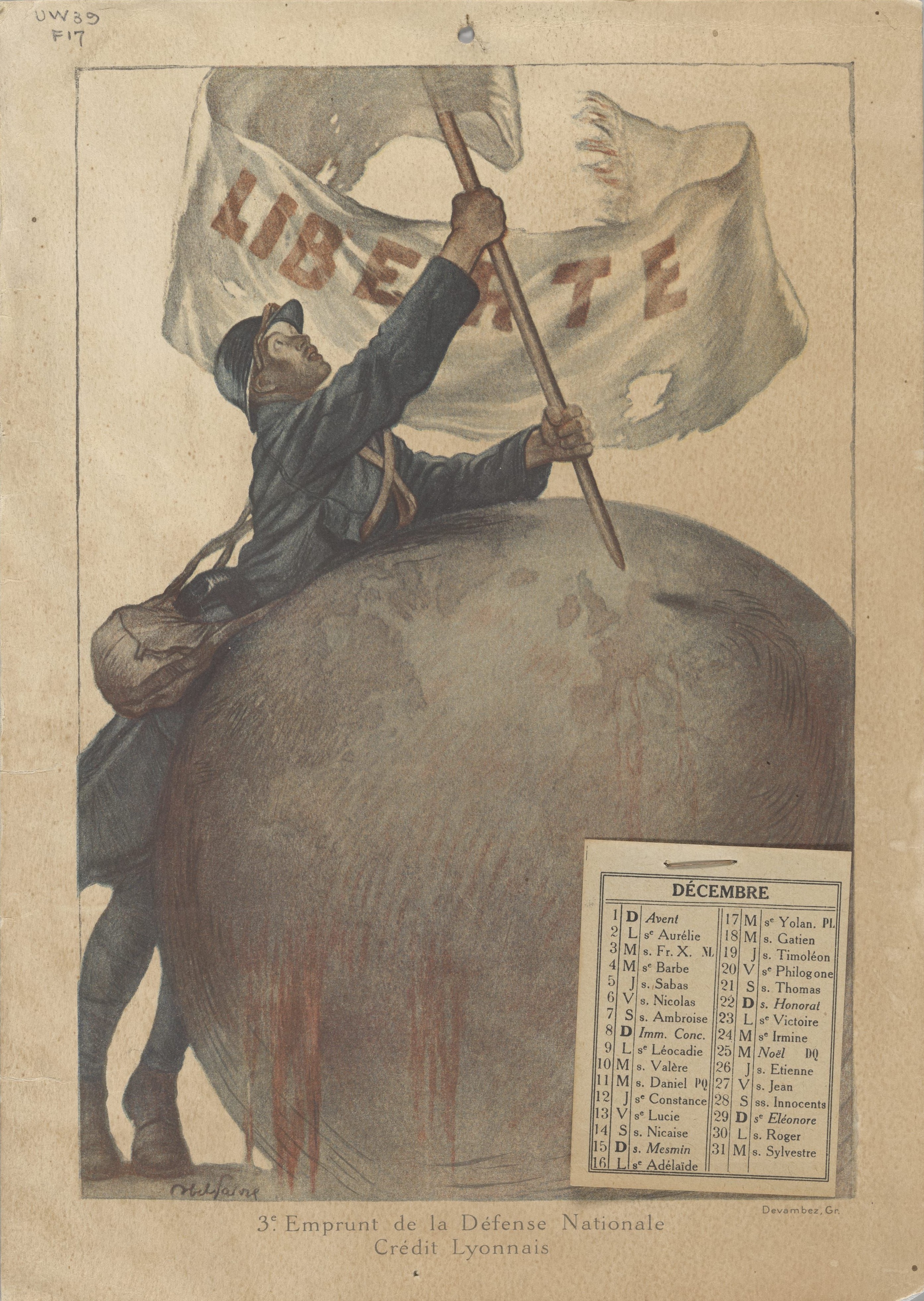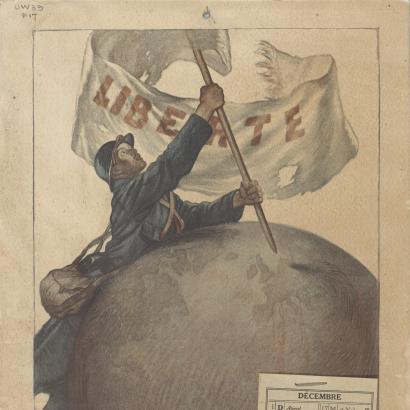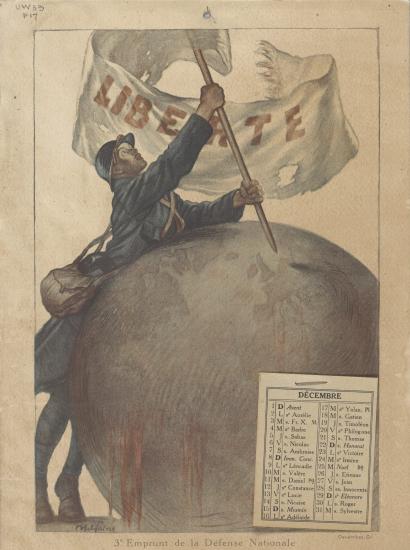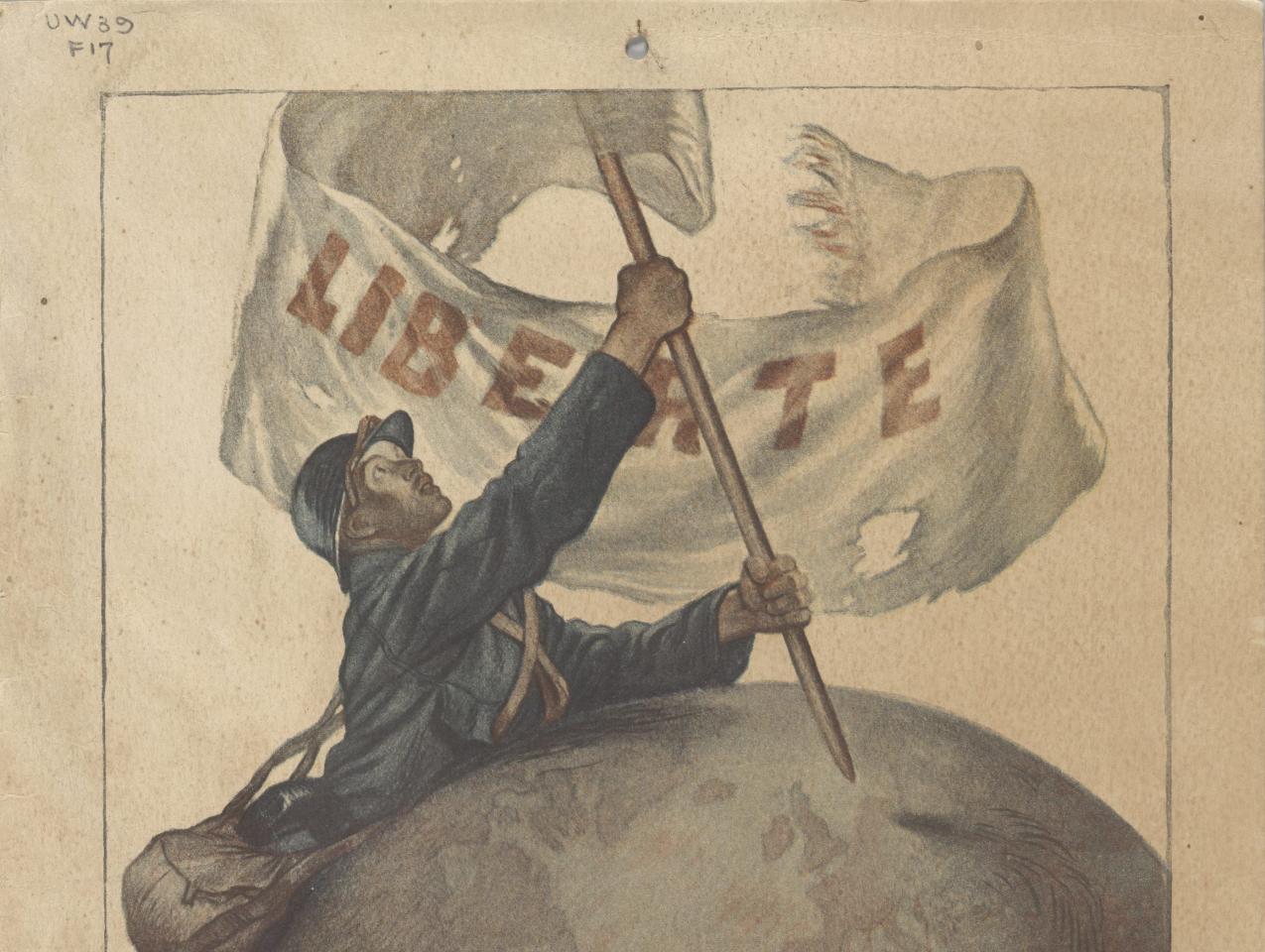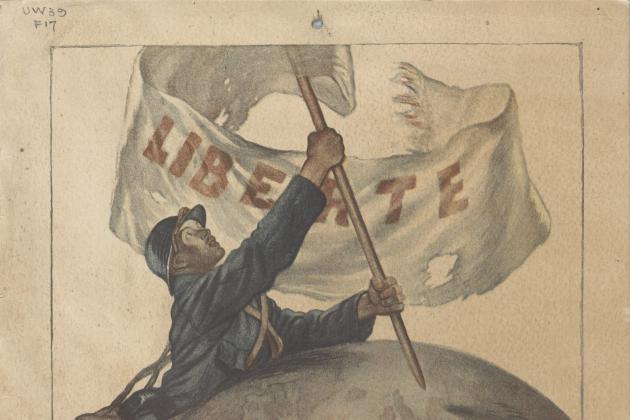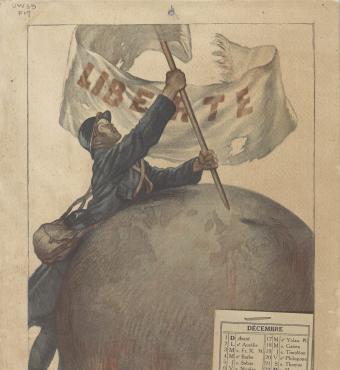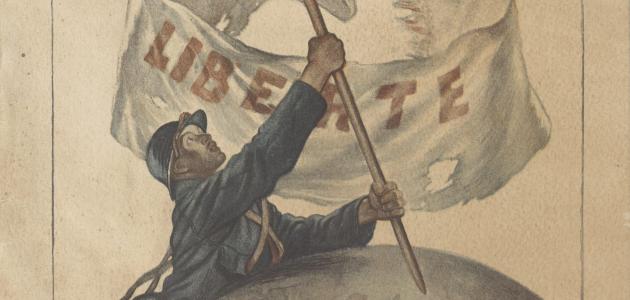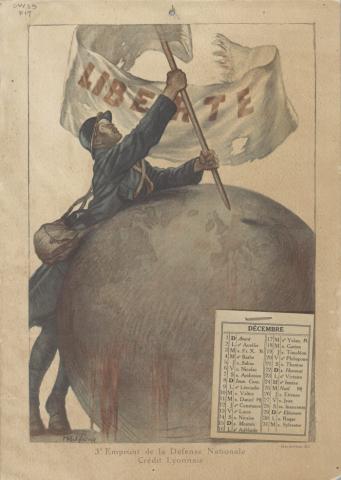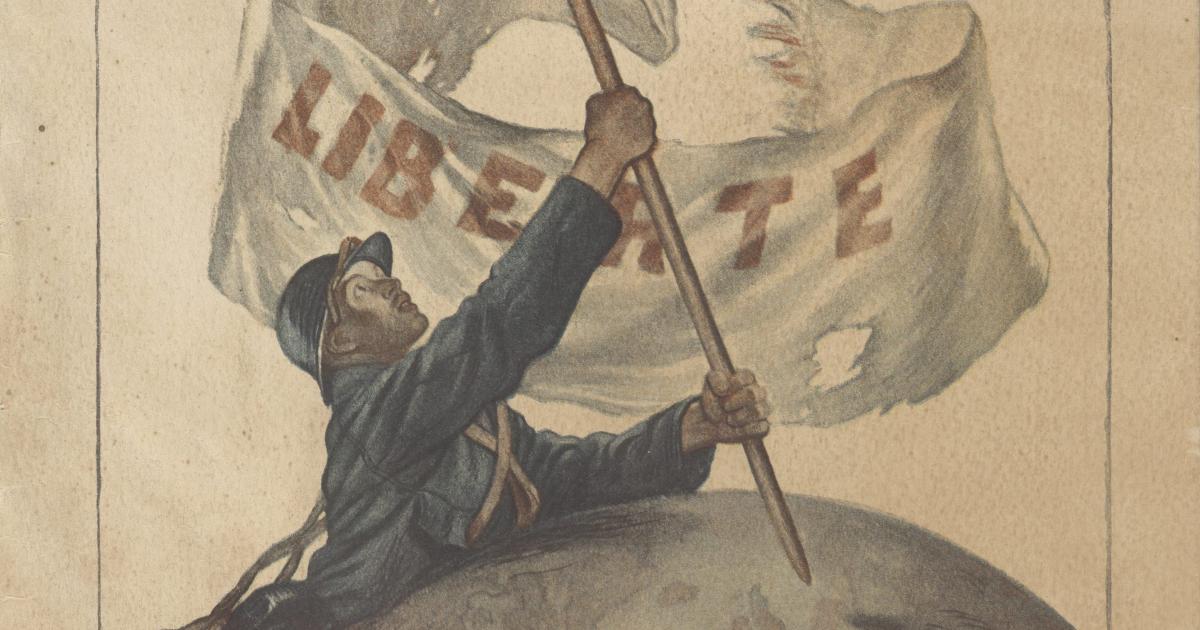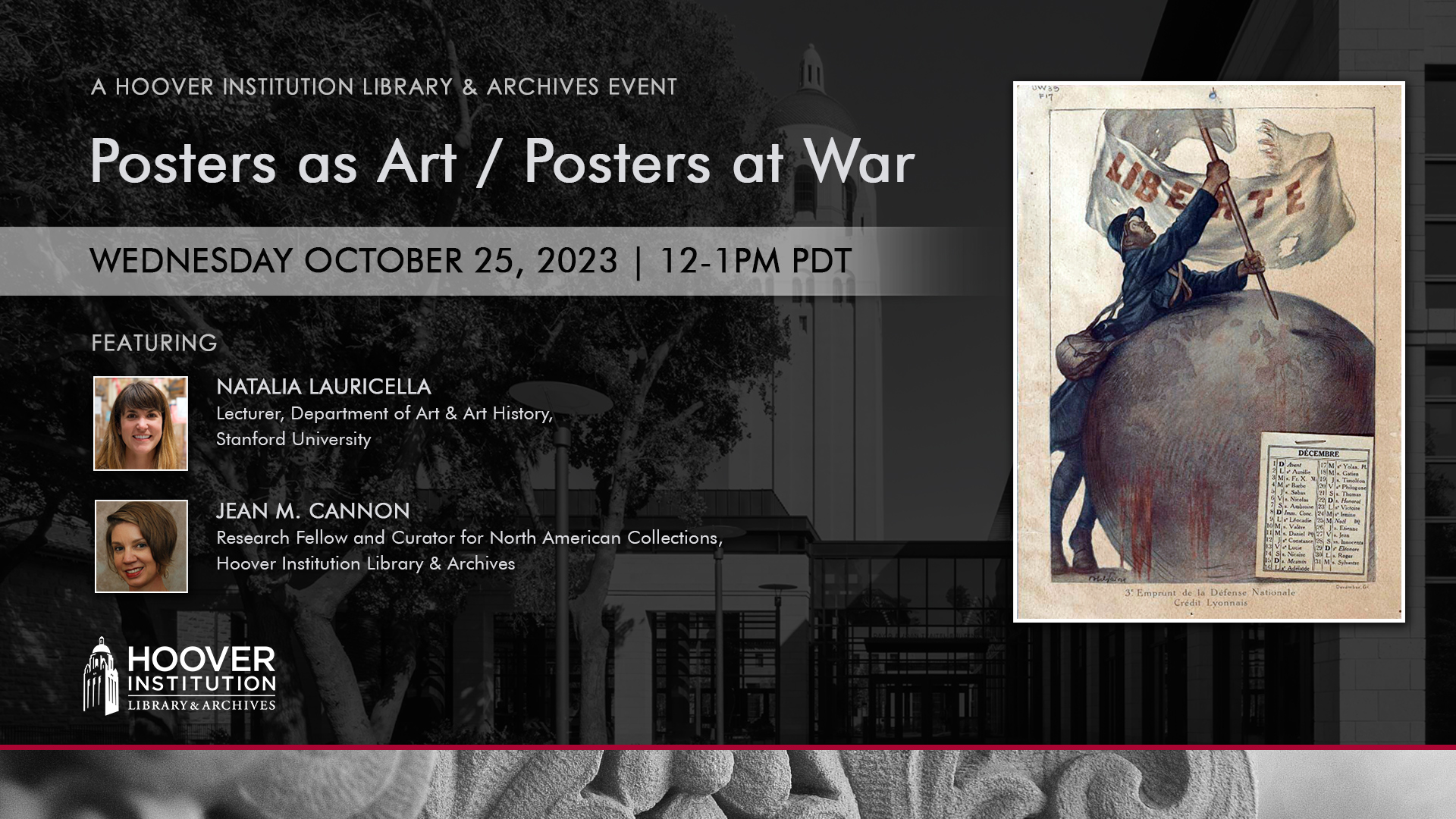Posters emerged as an influential form of art and communication in the 19th century, as new technologies made possible their mass production and wide distribution. Poster artists straddled the worlds of art and commerce and quickly deployed their work in patriotic service during the First World War, as belligerents expanded the political and propagandistic role of posters.
Two speakers reflected on the artistic and political dimensions of poster art in the early 20th century, drawing on the Hoover Institution Library & Archives’ renowned poster collection.
This event was held in conjunction with the exhibition Dynamic Designs: Transforming Posters at Hoover, currently on display in Hoover Tower through December 20, 2023. More information about the exhibition and its online component can be found here.
>> Eric Wakin: Good afternoon, everyone. I'm Eric Waken, deputy director of the Hoover Institution and the director of our library and archives. And it's my great pleasure to welcome you to today's talk by Natalia Lauricella and Gene Cannon on the subject of posters as art posters at war. Before we get to our talk, let me thank a few people at the institution who've made this event possible.
First, our director, Condoleezza Rice, for her support of the library and archives and our programs, and the overseers of the Hoover Institution. These are our board of directors and other donors without whose support nothing we do would be possible, because our institution is almost entirely privately funded. Also, I wanna thank my colleagues in the library and archives for their work on this program and all they do, especially Samira Bozorgi, Bert Pattonout, and many other colleagues.
We're here at the library and archives because of the vision of one man, Stanford graduate Herbert Hoover, who endowed what was then the Hoover War library in 1919 with a $50,000 donation. That's about $800,000 based on today's purchasing power and the original instructions in his famous telegram, quote, collect material on war, unquote.
At that time, the entire Stanford Library budget was half of Mister Hoover's donation to found his war library, and there was no national archives in the United States. Since that fateful day in 1919, the Hoover Institution has become the world's largest private organization dedicated to documenting and studying war, revolution, peace in the 20th and 21st centuries.
On our library side, we've got almost a million volumes in our library and 6200 different archival collections with materials from 170 countries. As many of you know, a robust research center dedicated to ideas defining a free society, we support 200 residents and non resident fellows in fields like economics, history, political science, literature science, as well as fellows from the service branches and government.
Indeed, we're unique at being a think tank with a world renowned library and archives. Mister Hoover once said this about our mission, the institution is not and must not be a mere library. And I think this talk shows that while we have a robust public policy program, we also have this wonderful, expansive series of academic activities beyond the core library mission.
We work with students, we offer fellowships, we teach classes, we sponsor research, we offer workshops, we present exhibits, and of course, we offer talks like this one. So almost at the talk now, as soon as the library and archives was founded in 1919 as a collection of the First World War, some of the items that Hoover curators began collecting were wartime posters.
And we'll see some of those in the next hour. These were propaganda posters that were used to unify our country's citizens behind the war effort to encourage feelings of patriotism, at times by demonizing the enemy, and they were frequently used by the governments at war to raise money to finance war effort in the form of war bonds.
Hoover's poster collection is well over 100,000 posters now from around the world continuing to grow, and about 33,000 of those are available online. Today's talk is being held in conjunction with the exhibit dynamic designs transforming posters at Hoover, which is currently on display in Hoover Tower through December 20th this year.
It's a showcase for the remarkable variety of our poster collection. Today we have two speakers who know a lot about the artistic and political dimensions of the poster poster art in the 20th century Natalia Loricella is a lecturer in the department of Art and Art History at Stanford.
One of her areas of expertise is poster design in the late 19th and early 20th centuries. Natalia received her PhD in art history from University of Southern California. She has worked as a curatorial assistant of collections and exhibitions at the Guggenheim Museum in New York. Our second speaker is Jean Cannon, who's a research fellow and curator for North American collections at the Hoover Institution Library and Archives.
Before coming to Hoover, Jean was literary collections research associate at the Harry Ransom center, where she co curated the 2014 exhibition the World at War, 1914 to 1918. She was also the curator of Hoover's 2017 exhibit, weapon on the american political posters of World War I. There will be a brief Q and A at the end, please use the chat anytime during the presentation to submit your questions prior you submit your questions.
With that, we're gonna begin with Natalia Loricella. Welcome. Thank you.
>> Natalia Lauricella: Thank you so much for the kind introduction, Doctor Waken, and thank you to Bert, Samira, and Hannah and their colleagues at the Hoover for organizing this event. I'm just gonna share my screen with my slideshow. From their emergence in the early modern period, printed materials have circulated political, social, and cultural messages.
I'm showing you here a 16th century woodcut by Albert Durer, an 18th century engraving by William Hogarth, and a 19th century etching by Francisco Goya. The one drawback of these print media, however, is that they were typically labor intensive and did not yield a large number of impressions.
Printed images could circulate in books and as broadsides and pamphlets and as art prints, but large format, mass reproduced and colorful posters that we have come to know did not exist as such until the 19th century. This change began with the emergence of lithography invented by Aloha Sennefelder in Germany around 1796.
Lithography is a planographic process, meaning that the image is printed from a flat surface, or matrix. As such, lithography did not necessitate the laborious work of carving wood or incising metal that were part of the early modern print methods of woodcut engraving. Lithography is a chemical process based on the principle that water and oil resist one another.
It involves a thick limestone block onto which an image is drawn directly with an oil crayon. And here I'm showing you a couple examples of lithographic stones with images still on their surfaces from the 19th century. These are rare because oftentimes a lithographic stone would be reused by grinding down the surface.
You can see how dense these stones were, and you can imagine how heavy they would have been. And keep in mind that in printmaking, the matrix, often will be the reverse of the image that would be printed. So you can see that the text here is backwards but when the paper was pulled from it, it would have been the right way.
So the printer would use these stones. They would use an ink roller to apply a greasy ink to the stone surface. Once the image was there, the printer would then lay the stone in a press bed, place paper carefully atop it, and then pull the stone through the press so that the image was transferred onto paper through the pressure of the press.
As long as it was re inked, one lithographic stone could produce thousands of impressions, and this is really why it became a mass medium. Lithography immediately attracted printers because it offered an easy and efficient method for reproducing images. Early lithographs were monochrome or black and white, because these were easier and more affordable to print.
Monochrome lithographs served as illustrations in books, in journals in the form of caricature, like this one by Honore Daumier, or as reproductions or original works of art, such as this print by the painter Theodore Gericault. In these early years, when people did turn to color, printers had to hand color or tint lithographs.
For larger edition sizes, printers might have used stencils to expedite the process, though this technique sometimes made the quality noticeably poorer. In general, hand coloring was typically inconsistent. And such application became less practical the larger the edition size. In the second half of the 19th century, printing lithographs with color became much more common because of technological developments that rendered the process cheaper, easier, and much more efficient at a large scale.
So how exactly were these lithographs, which were called chromolithographs, made? This is a great didactic image from the 1890s. It was published in a trade journal. And it was intended to advertise the services of a commercial lithographic firm. So, to print in color, first a printer needed to copy various parts of an image onto different stones.
Although by this period, sometimes printers were using zinc plates rather than limestone because they were much lighter. The printer then inked each stone in a different color and layered each color on paper by pulling one stone after another through the press. The process of printing in color lithography was particularly exciting because of the effects of layering color on paper via separate stones.
Look at the way that this image is built through color. So this is at the top and the right. This is the final image and you see it here. And you can see how color was built through this layering of these different color blocks. So, first you have the yellow of her dress.
The additional color red here is applied, which creates the outline of the bottle. Then you have a peach color, the green, which is her overcoat, but also the label of the red bottle, and this continues. The image becomes more complex and more nuanced and more detailed with the additions of these colors that juxtapose each other, but also layer to create new shades.
Technological advancements in the design and production of steam presses in the second half of the 19th century enabled the rapid and large scale printing of chromolithographs. Chromolithography could produce incredibly vibrant images. I'm showing you here a few examples of chromolithographs that circulated in this period. One is a Christmas card on the left by the famous American publisher Louis Prang.
And the other depicts a scene from a Cinderella production. This was maybe the COVID of a music book. This was printed in London in the 19th century. Chromos, as these were known, were printed often on cheap, ephemeral paper via these large steam presses in industrial settings. They became widespread, advertising, consumer goods and entertainment culture illustrating journals and magazines.
And covering the walls of urban centers in the form of posters. As you can see in this painting, from 1882, early poster artists crafted their designs. To address the changing urban culture. One defined by commerce and entertainment. Intended to catch the attention of a viewer hurriedly passing by posters intrigued and informed.
They attracted the attention of viewers through scale, through bold colors, text, and composition, conveying information clearly about a product, venue, shop, or performance. One of the most influential poster artists of the late 19th century was Jules Cheret, and we can see it once here, the visual impact of Cheret's iconic posters,.
The swirling and alluring central figure, expressive and energetic movement, clearly legible words, and vibrant and harmonious colors. From the 1870s onwards, his posters popularized chromolithography in the public sphere as well as the fine art world. I'm showing you here two examples. Both feature his iconic depictions of female figures.
These were known as Cherettes. Cheret often depicted these idealized figures in unidentifiable settings, making it difficult to determine the exact location of the depicted scene and evoking a sense of escapism, a respite from the bustle and stresses of urban life. His posters captured the lively visual culture of the period, and his colorful posters, which could be found everywhere in Paris, inspired many artists to work in the medium.
Czech artist Alphonse Mucha was another major poster designer of this period. His posters stand out because of their surprising flatness, the elegant weaving of monochrome and multicolor palettes, and mosaic backgrounds, which were clearly influenced by Byzantine artwork. Many of his posters feature a romantic female form depicted in colorful theatrical poses, wearing ornate garments and precious gems.
Here are two examples. At left is an advertisement for a printer's service. The woman holds a book of prints on her lap as she is surrounded by elaborate organic motifs typical of Mucha's art nouveau style. The visual language of the poster is striking. The flowers in her hair and those framing her in the background are the same color.
The soft beige shade of her dress and the pink floral accents in her hair visually echo the palette of the prints in the album book she holds, reminding the viewer that she is also a printed image. The other image is of one of the many vertical posters that Mucha made for the actress Sarah Bernhardt, this one made of pale and cool blues, and grays and greens.
Bernhardt owed much of her fame to Mucha's numerous portraits. In part because of Mucha Bernhardt captured the allure of Belleco prints, the two decades on either side of 1900, a period that ended once and for all with the outbreak of World War I in 1914. Elements of design, color, and treatment of figure that we saw in these posters proved influential in the early 20th century, even as the medium came into increasing use by government and civilian entities looking to make public statements and draw attention to the war.
On the left is a colonial enlistment poster by French artist Maurice Romberg from 1918. On the right is a women's suffrage poster by an American female artist, Evelyn Rumsey Carey, from 1917. We can see the similarities between these two posters and the posters of Cheret and Mucha. The central figure in Romberg's poster is male.
Certain aspects of his depiction remind us of Cheret's Cherettes. The figure is in the midst of action, in this case riding a horse. And it is unclear where exactly the rider is, except because of the clouds that you see at his feet, which seem to suggest that he is somewhere above the material world, perhaps in a dream, perhaps in the clouds that somehow show the distance between Algeria and France.
The pastel palette of yellow, pink, and beige is soothing to the viewer's eye, but nevertheless draws us in because of how the scene is basked in light. We see the dramatic rays of sunlight behind him, an appealing image full of energy and dynamism, one that obscures the dark side of the french colonial project.
The artist aimed to inspire the viewer. In this case, the intended audience would be young men considering enlisting in the colonial army of Algeria to help fight for France. Indeed, the french words resemble arabic writing, and the poster includes words in Arabic as well, a clue to us that the designer hoped to intrigue a wide audience and many recruits.
Harry's image, on the other hand, is much more subdued. The central female figure is cast in cool tones of gray and pale and deep blue. Nevertheless, the poster is ornate, featuring gold framing and gold accents in the main image. It says women suffrage on either side in those old columns, and in the middle, give her up the fruit of her hands and let her own works praise her in the gates.
The earthly motif we see here, her dress grows from the tree roots and her hands and fingers elongated into branch And fruits remind us of the visual techniques of Mucha's organic art Nouveau style. The poster is also of the same vertical style of Mucha's posters. The format reminding us as contemporary viewers of how large this poster would have been.
Carrie's poster, in support of women's suffrage, appeals to the viewer with a softer image, more inviting of contemplation and reflection. Other posters draw on similar artistic tools of central figures, obscure space, and harmonious colors to engage audiences through visual clarity and emotion. This is a poster designed by artist Fred Spear from 1915.
The poster's two tone composition is striking, and Spear uses color contrast to create a dynamic scene. A poster features a young woman holding her infant in her arms with a peaceful, almost serene expression. She is cast in lunar shades of white and beige, floating in a space that is at first difficult to identify.
Her weightless quality in the way her hair and her dress float above her, along with the more obvious clues of bubbles emerging from her mouth, reveal that she is underwater. A murky green atmosphere surrounds her, with vague markings on a lithographic stone surface that materialize fish and kelp hovering around her.
So, right up here and right down here you can see that there's these markings. She's at the bottom of the sea, viewers passing by or stopping for a closer look would have recognized her immediately. Imagined though the scene may be as it would have been impossible to see her in the water like this.
She was a passenger from the Lusitania, a British ship carrying some American passengers that was torpedoed in May 1915 by a German submarine. Relying on his viewers prior knowledge of and outrage at this event, Spear includes only the word enlist in a muted red tone, a complementary color to the green of the scene.
In another American poster with more muted earth tones, we have a reference not to a contemporary event, but to a famous historical uprising. I'm showing you here Paul Honores poster from around 1917. This is what we might call a more academic aesthetic that resembles painting. A young woman simply dressed in clothes of a historical era carrying a drum strapped around her neck, takes up most of the image.
To her right and left are other women, focused and stern, and there is a crowd behind these three central women. We can see silhouettes of other figures against the bright orange sky at the horizon. These women are marching, we can't see where they are going, but we know that they are united and they are determined.
This is the so called spirit of women power that Honore references in the clear text below the scene. Honore uses this anachronistic depiction of French women peasants uprising during the French Revolution of 1789, as a way to generate enthusiasm and energy to inspire American women and organizations in the US to promote the US war effort.
And I wanna bring in here an example of a famous revolutionary painting by a French artist named Eugene Delacroix, whose painting here is of the July Revolution of 1830. Though Honore's image hearkens back to 1789, the aesthetic of this poster is reminiscent of French romantic painting of the 1830s.
We have a similar central figure grouping behind her action scene, similar movement and energy of line and form in both of these. Not all posters from the period relied on vibrant color to intrigue viewers. Here we have Theophile Alexandre Steinlen's monochrome poster of Russian prisoners of war from 1917.
The scene features two figures huddled together, staring out with vacant eyes. They fill up most of the poster framed by the two posts on either side. Are these posts part of the fence or without the entryway to the prison? The caption for the image translates to an enemy country, Russian prisoners die of hunger.
It appears carved in the wooden plaque above them, could this be meant to resemble a message of plea carved by the prisoners for the viewer to see? Figures in the background give us a sense of how many people live in this prison and how far back the prison space goes.
Steinlem cleverly uses the white of the paper, which is known in printmaking as the reserve, to represent the snow of this cold and inhospitable setting in which prisoners find themselves behind a barbed wire. The emotion of the scene is captured in part by the way the figures are rendered.
The marks of Steinle's lithographic crayon are evident in the way he's filled in the clothing of the two central figures. Indeed, this poster hearkens back to the early days of lithography, when the medium was used to reproduce drawings. Here it looks as if we have Steinle's sketch of a scene, as though he's there witnessing the suffering firsthand.
The strategy might have been used to create a sense of immediacy for the poster's viewer, at first drawing them in for a closer look and then inspiring action. Steilen was a well known French poster artist of the late 19th century, and here I'm showing you some of his most well known posters, one for the nightclub de Chanois and the other for a milk product.
Red and black inks dominate these posters, which feature strong silhouettes against blank backgrounds. The 1890s posters I'm showing you by style and illustrate the dynamic breadth of lithography's capacity to use simple design and monochrome or polychromatic palettes to convey a message in both expressive and abstract ways. Artist Jules Abel Faivre also opts for a simple design and palette of charcoal and brown in his 1916 French poster with the caption enles or we'll get them.
Faivre's figure is of a young soldier, it's dynamic. His arm is outstretched as he looks over his shoulder behind him, perhaps encouraging his friends and fellow soldiers and in turn USD the curious viewers to follow him. Faivre uses the rectangular surface of the lithographic matrix to his advantage.
The figure seems to come from the left and at any moment will pass through to the right. Faivre captures this energetic movement in a clear diagonal line from bottom left to top right, the strong line paralleled by the soldier's rifle. The tones of the figures, dressed muted as they are, stand out because Faivre has chosen not to include anything behind the young man.
The cream of the paper is in stark contrast with the figure. He really pops out at us, and this is similar to Steinlein's strategy in his cabaret posters of the 1890s. The occlusion of text here is not incorporated into the scene as it was with Steinle's poster. Rather, it stands out clearly against the white background en les o, written out as if directly on the paper by hand.
Handwriting that is echoed beneath the typed text below with the words Souscrive or enlisted. With a simple poster design and muted palette, Faivre created one of the most famous posters of World War I. Other poster artists of the period took advantage of a simple palette, using black and white and stark contrasts to brighter tones.
Here, for instance, are two posters by the British cartoonist and poster designer Bert Thomas, that play on civilian guilt to garner support for the war bond's effort. On the left we have a color lithograph that features two soldiers, identifiable by their headgear, who stare out at us as they seem to emerge from the depths of a black background.
This is another instance when the absence of ink on paper, the white of the reserve, is particularly effective, especially when highlighted by the soft grays that give the men's face their contours. Above and below them, Black text pops out from an orange background. You buy war bonds, we did our bit.
In the text you and we are bolder and larger than the rest of the font, creating a direct connection and contrast between the viewer and the figures depicted in the poster. The poster is unified in its design elements of image and text carefully and effectively placed. The poster's simple and straightforward legibility, as well as its appealing design and color palette, would have undoubtedly made it one that passers by lingered over on their way to or from work.
Thomas's other poster at right uses a similar palette of orange, black, and gray, though this time in a more complex composition. Against an orange sky, we see the silhouette of a cannon, its barrel at an upward diagonal, pointing toward the battlefield, ostensibly at the right. The cannon and soldiers, printed in gray, are outlined and highlighted in black, and even the reserve of the white.
You can see here, right at the center. At the back of this central figure, beneath this group, is the text feed the guns with war bonds and help to end the war. Unlike in the other Thomas poster, these words are composed of white, the reserve scraped out of the black background, outlined in the same orange used for the sky.
Again, we have a cohesiveness or unity of the poster, achieved through form and color. The words intended for the viewer, who are British citizens at home, echo the colors of the sky above the soldiers in battle, drawing a connection between the actions of the soldier and the potential help or action of the civilians.
The message here is clear. So we've been discussing how poster artists might have intended to convey their messages in clear and appealing ways. But how do we know how people felt or what they thought when they saw these posters? And this is one of the hardest parts of studying posters, because we are often left unable to track reception history.
Sometimes a poster publisher would reprint a poster. So we have a sense of how many, how popular a particular poster image might have been and how effective it was. Sometimes posters were carefully preserved, as was the case with the ones we looked at today, because of an appealing design, or perhaps they were the work of a famous artist.
But what we can think about is format. Although it might not be clear from this PowerPoint presentation, these are not small prints, and they were not intended to be held and experienced in any sort of intimate or personal way. These were typically large, around two and a half or three feet by three or four feet.
They were pasted onto buildings, walls, Morris columns, intended to be seen as people passed. In other words, they were very public, and their reception would have been part of a shared experience, an experience of communal looking. This brings up the idea of imagined community, a term developed by a scholar named Benedict Anderson, writing about newspapers and the formation of shared perspective by way of individualized experience occurring en masse through engagement with print.
While unfamiliar with one another's identities, people could imagine their shared existence in their simultaneous performance of this action. Whereas Anderson focused on newsprint and the importance of this form of, quote, unquote, print capitalism in the origins of national identity. It is fruitful to explore how the shared experience of viewing posters, a different form of printed matter, also contributed to the creation of a national culture and identity.
This understanding that a viewer was not the only one looking at a poster, it might have inspired feelings of nationalism, pride, honor, guilt, shame. All of these were emotions that the designers of these posters and their publishers hoped to evoke from their viewers, often to encourage them not only to feel, but to act.
So now that we've covered some of these artistic strategies involved in making a successful poster, I'm gonna hand the mic over to my colleague Jean Cannon, who's going to walk us through some of the political dimensions of these posters. Thank you.
>> Jean M. Cannon: Okay, thank you, Natalia. That was great.
And thank you to everyone for joining us today. I'm just going to share my screen quickly. I am delighted today to have the opportunity to discuss what might be my favorite collection at Hoover. And, yeah, delighted to be here with my great colleague, Natalia, with whom I've taught many classes here at Hoover using the poster collection.
And Natalia, as we've seen, is the real expert on the composition and craft of posters, whereas my own research in this genre has focused more on the social and political context of posters. Particularly as those relate to the first World War, which, in my somewhat biased opinion, really is a golden age for the art of the poster.
So today I thought I would discuss the great war and posters, with a focus mainly on american posters that are drawn from my curatorial area here at Hoover. I'll also mention that there are more than 10,000 american posters from World War one in the collection. So we are really just looking at the tip of the iceberg today.
But my goal here is to explain a bit of the history of how and why posters were produced in mass, in America, in the world War one era, and to look at some of the strategies in terms of propaganda and public opinion that were being pursued by these designs.
Okay, so I wanted to start with these two images, not because we need a black cat for Halloween, even though that's nice, and not because I know we have a lot of dog and cat lovers in the audience. But because I think these two posters in particular really show off what color lithography of this time period can do.
I remember many years ago when I first started researching for an exhibition on World War I. I went to the stacks to look at posters, and I expected to find faded ink and crumbling paper. Instead, I opened a drawer, and the first poster I saw was this cat.
And I honestly thought it was going to jump out of the drawer and claw me. So I always use this poster as an example of how eye catching this particular mainstream art of this time period can be. And I think that's really important in the context of World War one.
We need to remember that this is a period before broadcast radio and broadcast tv, when the average civilian walking down the street, not looking at their phone, had a lot more attention to give to their surroundings. So propaganda posters become, as one critic put it, weapons of mass communication.
Okay, so many historians argue that the first World War was the full expression of total war. And what they mean by that is that it's a war that is waged not just as a professional army fighting another professional army, think Napoleonic times, but a war that is waged against an entire society, including civilians.
I think this is a big but somewhat sweeping claim, but it does point out how mass print media would become so important during this time. So, in this poster, for example, as Natalia discussed earlier, the drowning mother and child represent civilian victims of the Lusitania shipwreck. And the artist doesn't even have to reference the Lusitania or say, remember the Lusitania, because the attack was so shocking and so top of mind for Americans.
It had been the news specifically because it was an orchestrated attack against civilians. And that was so unusual. Nevertheless, let's remember that the Lusitania sinks in 1915, but it is not until 1917, a full two years later, that America actually enters the first world war. So within that time period, there's this raging debate in America between interventionists.
And non interventionists. On the one hand, some people think, you know, this is a european war. Why would we throw lives and money at something that doesn't concern us? We're separated by an ocean. Let's stay out of it. Other people say democracy is in peril, sovereign nations are being invaded and occupied, and we're obligated to get involved.
I'm sure this sounds familiar to you all. This is a debate that happened during World War one, World War two, yesterday and today, in 1917. However, the US does indeed commit to the war, and President Woodrow Wilson knows he has to galvanize public opinion and bring people together behind the war effort in order to achieve victory.
So a few days after declaring war, Wilson establishes the first ever state bureau for propaganda in America. He calls this the Committee on public information. And he chooses an old friend, the journalist George Creel, to run the committee. So George Creel had done publicity for Wilson's campaigns and was a veteran of journalism and publishing.
He actually got his start in journalism as a joke writer for William Randolph Hearst. So here he is in the middle of this picture, looking decidedly like someone who does not write jokes for a living. But he was great at propaganda, and almost immediately, he uses his contacts to put together a group of Madison Avenue artists.
So think Mad Men of the 19 teens. And they were well known for commercial art and book magazine illustrations. He calls them the Division for Pictorial Publicity. And he puts another veteran of the biz in charge. And this is Charles Dana Gibson, who was one of the best known commercial artists in New York at this time.
You probably recognize his famous Gibson girl, who is featured here. The Gibson girl was an iconic, tall, thin socialite with bouffant hair, very popular in the 1890s and early 1900s, but quickly was replaced by the flapper. But Gibson knows everybody in the publishing business, but he faces the challenge of this.
How do you get a group of hustling New York artists to work for free? Well, apparently, you use an age old tactic. You throw a party. So Gibson establishes a weekly meeting at Keynes Chop House on 36th street in New York. So basically, he says, okay guys, you come over to Keens on Wednesday night, and you're going to serve your country by having a martini and sketching for your government.
A representative of the Committee on public Information would come up by the train from Washington, DC, with a wish list. So, you know, we need a poster for food conservation this week or what have you, and these guys would sit around the table and smoke their pipes and sketch.
So a lot of these posters were drawn very quickly and with a lot of urgency, and you can kind of feel that in the design. And also, just side note to show you what a nerd I am, this is a picture of Keens Chophouse that I actually took the last time I was in New York.
And on the right, there is Herbert Hoover's pipe on display in the foyer, as he used to hang out at Keynes as well. Okay, so who are these artists? Many of them are well known in New York. So, for example here, Joseph Pennell. Pennell was actually a Quaker and a pacifist from Germantown, Pennsylvania.
However, he happened to be in Berlin in 1914 when the war broke out, and he was just horrified by what was happening. And most of his art, as you can see here, really emphasizes a fear of invasion. So here in this poster, you see planes coming into New York harbor.
And I feel like whenever we show this poster in a class or a tour, everyone immediately thinks of 9/11, right. On the other side of the spectrum, we have a very young Norman Rockwell who's participating in this effort. And Rockwell, he's only 20 years old when the war breaks out in Europe, even though you can see here he's already drawing cover art for the Saturday Evening Post.
So he's already made his mark. He's kind of the up and coming little brother of the Keens Chophouse club, if you will. And you can see that his style is already pretty firmly established. He draws a lot of children. He uses a lot of homespun humor, and somehow he's able to put this into patriotic context here.
So, for example, on the right, you have this adorable child sporting his victory pins. And you can surmise by the wad of cash in his pocket that war loans are proving to be more lucrative than his paper route. Okay, if there's one person who is the sort of Don Draper of this group, if you will, it was this gentleman, James Montgomery Flagg.
And so Flagg was a sort of fun and flamboyant New York personality in this time period. He had been drawing for the magazine since the age of 12. So he was a regular on Madison Avenue and a huge backer of the war effort. But maybe his biggest achievement of this era, as you can see from this photograph, is he was famous for, he was famous for drawing the I want you poster.
And if you look closely at this picture, you can see that Flagg actually modeled the picture of Uncle Sam on his own face. And again, he was designing this poster very quickly. So he just used what he had, which was his own face and not a model. Okay.
However, the funny thing about that is that as Flagg got older, he actually more and more came to resemble the image that's in this poster. So in this picture, he's dressed up. But he actually did end up looking somewhat like this at the end of his life. But Flagg was very skilled in stealing, or shall I say, borrowing designs.
So keeping in mind that war breaks out in Europe and in 1914, and America doesn't join until later, these artists, you know, they had had a few years to see what designs were coming out of other countries and assessing what they thought was successful. So here on the left, you have the prototype of the I Want You poster, which is a British poster featuring Lord Kitchener, who was the head of the Navy for the British.
So this poster was very popular in Britain. So Flagg just redesigned it, shall we say. Flagg was also innovative in some other ways. Open-air publicity was one. He came up with this great publicity stunt in which he sketched war posters on the steps of the New York public library in midtown Manhattan.
So, for those of you who have been watching Ghostbusters this Halloween season, he's doing this right beside the famous lion statues that are on Fifth Avenue. So, basically, Flagg publicized the fact that if you wanted to give $1,000 for a war bond, he would sketch you on the spot.
He would make you a model for a poster, which you can see is happening here. So this was just gangbusters in New York and ended up in all the newspapers. And so this is the result of that particular stunt of that day. Okay, so let's just look at some of the types of posters that these artists were creating.
You can sort of group them a bit thematically, if you will. First and foremost, they were producing recruiting posters. We could probably spend an hour just on recruiting posters alone. But I'll show you a few here and get through a few of the strategies. When the war broke Breaks out.
America has a very, very, very small army, and so it is crucial to have people enlist and to build up munitions. And so recruiting is sort of the first on the agenda for these guys. In this poster on the left, this was actually done by a young woman named Laura Bray, who was an art student in Chicago.
That was another. She won a contest that the division of pictorial publicity put together. That was another way to get basically free art designs is to have a contest. And you can see, it says, on which side of the window are you? And in the forefront, you have a sort of dandy, dapper character, looks almost like a character from a Fitzgerald novel, and he's looking out, out the window toward soldiers walking away.
So this is an example of shaming, which actually comes, comes into play with a lot of the slogans that are on these posters. And then, on the other hand, you have posters like the one on the right that are sort of appealing to the adventure of joining the service and going off to war and going to exotic places.
And the Navy certainly had some of the most vibrant of these types of posters, as you can see here. Other posters also offer technical education. So learn to fly a plane. Learn to become a mechanic. Better your life. That was a common strategy as well. Now, of course, in this time period, women were not officially allowed to join the armed services.
That would not happen until 1948. But there were certainly many ways in which they served the war effort, and many posters were address this. So many served as volunteer nurses, and also, as you can see by the snappy uniform on the left here, they served as ambulance drivers, which was dangerous work because they would have to go out into combat zones and administer first aid.
And also remember that very few men and almost no women knew how to drive or work on a car in 1917. So they had to do a lot of training. And on the right here, you can see one of the hello girls who worked on the western front.
So these were female telephone operators, mostly recruited from at and t. And they were instrumental in overseeing switchboards that connected both the front lines, the front trenches to headquarters behind the lines, and also commanders of different allied nations. Since radio was in its infancy in this period, they played a huge role in terms of communications in general.
But there were other depictions of women in uniform. So women become symbols as well, especially in this series of posters produced by Howard Chandler Christy. And he produced the Christy girls. They were sort of similar to the Gibson girls, and so the aesthetic is somewhat the same. But here, he's appealing to a sense of masculinity.
And then you can see on the right, he has his own sort of sexualized twist on the I want you poster. And, you know, as the suffragette movement starts to pick up pace, Christie eventually starts to move away from this type of imagery and revamps his career by painting powerful men, in particular, past presidents.
So, fun fact, if you visit the Hoover archives reading room, you can actually see a portrait of Herbert Hoover done by Howard Chandler. Christie looks very different than what you're seeing here. Okay, so these artists also, they created a lot of designs to address the home front. And this is a poster Natalia and I have used in class often because we both find it unusual in terms of both content and design.
Unlike most posters of the time period, it uses a lot of text, and the graphics are very detailed and busy. But essentially, this poster addresses the issue of hyphenated Americans within the labor force. It reveals that especially in large industrial cities, there was anxiety that hyphenated Americans, German Americans, Irish Americans, Italian Americans, might have more loyalty to their countries of origin than to America.
And of course, since a lot of immigrants were working in factories and shipbuilding, there was perceived threat of enemy agitation at home. And so, just in general, there are a lot of posters produced at this time period relating to industry in general. So here, you can see a shipbuilder in lockstep with soldiers and sailors.
As German U boats had decimated British ships early in the war, so Britain came to rely heavily on the US for shipbuilding. And also as more men volunteered to serve in the armed forces, women entered the workplace in munitions factories, particularly through the YWCA. The YWCA would put 26,000 women to work during World War one.
So I just love this poster on the right. And I always think of it as the prototype for the Rosie the Riveter poster that would come later during World War Two. And, of course, you can't have a series of dramatic war posters without spreading some fear of the enemy, as you can see in these very dramatic posters.
So in this poster on the left, you see Germany depicted as a savage brute, which will, you know, he will cross the ocean from Europe and destroy America, you know, with violent ways. And personally, whenever I look at this poster, I think of King Kong, even though, of course, King Kong doesn't come out until 1933, right?
But one fun fact I will share with you is that Hoover houses the collection of Marion Cooper, who was co director of King Kong and served in World War one as a pilot. And he actually met his collaborator on King Kong, who was a cameraman for the US army during the war.
So I always just speculate whether or not these types of images would have influenced that film. And then on the right here, I think it's one of the more dramatic posters of the war. You see the slogan remember Belgium, which is used over and over again in these wartime posters.
Belgium was invaded and occupied by Germany early in the war. And news reports of atrocities against women and children become a real rallying cry for the war effort in allied nations. Okay, but let's end on an uplifting note here. As Californian's love food, I have to show you some food posters.
Now, because of Herbert Hoover's extensive work providing food and medical relief to Belgium during World War One, we have an incredible collection at Hoover Archives that relates to food relief during the war, just in general. And as we are an institution dedicated to preserving history, I wanted to show you this poster on the left.
As you can surmise here from this image, food conservation is tremendously important in America. During World War I, citizens on the home front were encouraged to can food as patriotic. Preserves to plant what they called Victory gardens, and to have wheatless Wednesdays so that, wheat could be sent overseas to soldiers.
Early in the war, German U-boats sank nearly 2 million pounds of British wheat. So, essentially, America, you know, because of vast farms in the Midwest, becomes the breadbasket of Europe, and was sent food overseas in mass quantities. And then lots of new organizations popped up, such as the ones you see on the one you see on the right here.
These were known as the land lassies. Again, very snappy uniforms, and they were mostly blue stocking women from cities who went out to the midwest and farmed land for the war effort. This poster just has a beautiful design and color composition, and it's definitely a staff favorite, although there are many.
Okay, so I think I'm out of time here, but I want to encourage you all, if you'd like to learn more about poster art from many different time periods, not just the ones that we've discussed today, please do visit dynamic design, the exhibition that we currently have in the gallery that is in the Hoover Rotunda.
It's a beautiful collection of poster art from all over the world. Okay, so now my colleague Natalia is going to rejoin me, and we are happy to take any questions you have for us. We're going to give you a moment to get them into the chat. I wanted to start with, I'm going to ask you.
I'm going to ask the first question while other people are getting their questions together. I know that you have taught quite a lot on poster art and design, and I'm wondering, what is your strategy of bringing the posters and the history and the design techniques, like, alive for students?
>> Natalia Lauricella: Thank you so much for that question. As Jean mentioned, she and I have co-taught together. I teach a class at Stanford called the history of prints, propaganda, and protest. And so a lot of that is based on the technical kind of crafting of these images, as I talked about in my presentation.
So the class that I do incorporates visits to print shops and as much, you know, in person viewing of this material as possible, which is why, of course, we come to the hoover. So, to me, I think one of the most important things, and this is how I was sort of ending the presentation, was talking about format.
So how can we kind of get a sense of the way that a print, or in this case, a poster, would have had an impact on viewers when we think about some of the elements of its materiality, you know, obviously, things like the way that color is used and, you know, text and design, but also the format.
Right. How big it was, how it would have been in installed. That's what Jean and I can kind of talk about when we do this class together. I can give a little bit of the background of how these posters were made, and then Jean kind of dives in there with the kind of political context.
But I do really like this idea. And this is the kind of through line of the class, which is that, you know, from the very beginning that prince became a big part of western culture, they would have been circulating this kind of political and social message, whether it was in the form of a woodcut in the 16th century or up until we have offset lithography and other forms of digital hybrid processes later.
So thank you for that question. I actually wanted to ask you one, which is, if I can, which is where do you find these posters for the Hoover's collection? Are these typically posters that would have been, I assume from my own research and archival work that these might not have been posters that had actually been posted on the street, because those would have, speaking of materiality, would have been destroyed by rain.
People posting over them. Are these ones that maybe were, if you actually can, you know, find out this information, were these ones that were, you know, set aside by the publisher or were kind of in the extra categories or, you know, how exactly does that factor into the decision?
>> Jean M. Cannon: I mean, it's hard to know the provenance of all the posters, but you would assume because the posters we have are not gummed on the back, and most of them are in good condition. I think they would have been extras that were never actually posted. They printed these posters in the millions.
There would have been extra stores of them. Almost as soon as World War One ends, Herbert Hoover and his curators send people out to Europe, Russia and various places to pick up what's called ephemera, because things like posters disappear. People don't think of them as, like, art when they're first made.
And you and I show them in classes as art, but they weren't produced to be viewed like that. It's wonderful that they did collect so expansively so that we can kind of look at them as historical artifacts now. I'm going to let you, our colleague Samira, pitch us any questions she may have.
>> Samira: Yeah, we have a lot of questions from the audience. Thank you both for your informative and educational and visually interesting presentation. We have a question about, this one's for Jean. George Creel is considered the mastermind of US propaganda campaigns. Which poster or set of posters in World War One did he consider the most effective in recruiting American doughboys?
>> Jean M. Cannon: I've not come across anything that actually states what his opinion was about what was most effective. As Natalia mentioned, it's very hard to know what the reception was. I mean, I would say the I want you poster was wildly successful, and that was definitely one they printed in the millions.
But, yeah, I would have to research further, actually, to see if he actually, you know, ever expressed an opinion on what was most successful.
>> Natalia Lauricella: And just to jump in there, it's sometimes hard to know. Yeah. How many were in a print, what's called a print run. Right.
How many they decided to print. Oftentimes I will, in my own research, find what they wanted to do as the print run. Sometimes they just sort of stop in the middle. Sometimes they reprint. So that kind of archival material is hard to find. As Jean was just saying to pinpoint exactly how many exist is, especially when we're in this kind of land of ephemera, where these were in the hundreds of thousands, it's pretty hard to find out.
>> Jean M. Cannon: And the records are somewhat incomplete. Like, we have a collection for Creel, but it doesn't really have all the numbers in it. But I know that some of the more dramatic ones, say, for example, the remember Belgium poster, that is documented, and they printed that in the millions, too.
>> Samira: Thank you. And this is a question for both of you. What do you sense is the relationship between political and entertainment value in these posters for their makers and period audiences? Which matters more for visibility because there's so much overlap both in the history of the forum and in their visual language?
>> Natalia Lauricella: Do you want me to take that one, Jean, or do you want.
>> Jean M. Cannon: Well, you start. I've got an idea, but you start.
>> Natalia Lauricella: Yeah, I will happily. The way that I was tracing the early history of these posters is that they were certainly connected to these urban centers in which entertainment culture was becoming a much bigger deal.
There's a really great text by Susan Sontag on the poster where she. She calls poster design all about this aestheticizing impulse. So some of the ones that I showed you, I think, really have that kind of, they're trying to draw you in. There is a kind of luring message that's at stake there that I think could be similar to trying to attract an audience to a certain performance or a certain shop.
And there's a certain idea of selling that's going on here. And then Jean, brought in some more interesting examples of how they're just more kind of ominous materials, perhaps, in the kind of visual language that we're seeing there. So I would be curious to hear what Jean has to say.
>> Jean M. Cannon: Yeah, well, I was struck when I was listening to your presentation. I was thinking about differences in the posters based on the nations that they're coming out of, right? So you're kind of drawing from a French tradition, and then finding continuity in images that have more negative space, that aren't quite as busy, that don't look as much like typical advertising that we would recognize now as such.
So I kind of feel like the French posters pull from fine art, the Russian posters pull from kind of constructivist art. Whereas the American and British posters pull more from really commercial and magazine culture. So I don't know if you see that in the posters that you've looked at.
>> Natalia Lauricella: Definitely, and I think I brought in the choice to bring in Cheret and Mucha, this is kind of in the narrative of poster history, these are two major figures. There are certainly many others outside of France, but even within France, and those two artists are quite distinct in that kind of simplification.
And Mucha, you couldn't call them simplified, but his kind of aesthetic choices are quite distinct. There are a lot that even some of the ones that Jean brought in that have a lot more text. I'm talking about entertainment and kind of these commercial posters in the late 19th century that are much more text heavy, much more kind of complex designs.
As I showed you, the chromolithographs that they could possibly produce were incredibly detailed and dramatic. So the choices that Mucha and Cheret were making were taking this medium into a kind of a different, almost avant garde, very modern tradition. And so I definitely was tracing that with those early posters that I showed in the presentation, kind of transitioning from late 19th century into World War I.
But I think there is definitely a wide variety, especially if we didn't really bring in too many Russian posters, but they're very social realist. They're definitely coming from their own other artistic aesthetic of the moment.
>> Jean M. Cannon: Yeah, it does seem like Cheret and Mucha are really the bridge because they are fine art but very aware of the advertising angle of it, yeah.
>> Natalia Lauricella: Thanks for that question.
>> Samira: Yeah and actually, your answer to that question answered some of the other ones that are kind of questioning political posters and how they live in a liminal space between art and politics. And how the context in which they're viewed changes their meaning, so if you had any additional comments on that, that was one of the things.
>> Jean M. Cannon: I think this is something we talk about in our class quite a lot about how we are reviewing it in a library or a museum. And that sort of can change the meaning, sort of. I don't know, what do you think, Natalia?
>> Natalia Lauricella: Definitely, I mean, kind of the practice of collecting these things and putting them into libraries and museums obviously takes them out of the circulation that they would have been originally seen in, right?
That's why I wanted to include that one painting of the streets of Paris in the 1880s and included the one at the end with the Morris column. It's hard to find this kind of archival imagery, and I know Gina and I talked about this. What kind of images can give you a sense of how these things were viewed in their contemporary moments?
But I think Jean and I were trying to, in our presentations, also ground us in what's called a period eye. Which is, how do we reimagine how someone living in this period would have seen this? What kind of feelings would they have had, which are very different from us as historians in 2023, looking back on these posters?
But again, things like format and imagining where they would have been, seen imagine kind of coming around a corner and being struck by one of these posters on a wall or on a column. Or seeing a whole group of people looking at them together and being curious and wanting to see what the kind of fuss is about.
These are important things to remember, the kind of context of viewing would have probably really transformed how people felt when they looked at these things.
>> Jean M. Cannon: In our archival world, it's always golden to find an actual picture of these posters on the street, or especially people looking at them.
And, where are they, when is this happening, how are they posted?
>> Natalia Lauricella: Yeah, I mean, imagine also seeing them next to each other, right? We also don't know exactly how someone would have confronted one of these posters in the context of, yeah, if it was surrounded by entertainment posters or maybe other enlistment posters or were there conflicting posts.
There is a context is important to try and keep in mind as we're especially trying to think about this reception history, which is often very tricky to pinpoint.
>> Samira: So I know we're pretty much out of time, but maybe we have time for one more question? So can you speak a little bit to the importance or value of being able to access these posters in a digital format or online, how has that changed?
Maybe Natalia, for you, you're teaching, and Jean, also for your engagement with the collection.
>> Natalia Lauricella: Natalia, I'll let you talk. Yeah, having them digitized is an incredible resource. So, as I mentioned in answering Jean's questions at the beginning, it's really important for me, when teaching the history of print and printmaking to bring students in as much as possible to see this material in person.
I worked very closely with Jean and with Bert in the various visits that I've had to the Hoover to identify certain posters. And I can get a much better sense of them as they're digitized. I also have the resource of Jean's vast knowledge of the collection. So we go digging in the archives together and can look at some of this material, but as a scholar, I mean, these are hard.
This is something, I was thinking about even when captioning my images, they're not really titled. They're kind of, the titles are just sort of the text on them, it doesn't give you a sense of what you're actually looking at. So having that digital representation as you're doing your research is just kind of completely changes how you can gather information and what kind of close looking you can do even online.
Which is not the same as doing it in person, for sure, but it makes a big difference.
>> Jean M. Cannon: Yeah, agreed. I mean, I think it's been wonderful. We have here 130,000 posters, we've digitized 33,000, and we have another project going where uncatalog posters will be digitized. And so, it's wonderful for scholars who can't access our reading room, for example.
But also it's wonderful to be able to just quickly search for them and compare and contrast. That's, absolutely essential, really, when you're looking at these posters because they don't exist in a vacuum. They're of a time period, they're reacting to one another, people are copying design, as I mentioned.
So, that is just, Fantastic resource to be able to have a wide catalog of these that you can use very quickly, I think. Although, as we know, nothing competes with seeing them in person, especially because of, as you mentioned, their size and also the vibrancy of the color.
The fact that after a century, these can be just as effective, and they want to jump out off the wall at you. But the digitizing them made them available to a wide audience, I mean, it's been very popular with researchers, too. They love it cuz they can use it in classes and in books and writings, yeah.
>> Natalia Lauricella: Right, but just to add also, I think what Jean was saying is there's a huge difference in actually coming to see them in person. Because there are some things that even in terms of the way that they were used and the kind of the material remnants of their history is so important to consider as well.
It's exactly as Jean was saying, how bright are these colors? How much have they faded? Have they not faded? But also, are there kind of any indications of how these posters, were they installed? Can you see if there was gumming on the back? Can you see if they were ripped?
Things like that, how are they stored? It kinda gives you a sense of their history as a material object as well.
>> Jean M. Cannon: Yeah, their life as a material object, yes.
>> Natalia Lauricella: You can look at the process. I mean, this is not quite the same for Hoover. But in the Mooca posters I showed you, some of them are so big that when you actually see them in person, you realize that there are different sheets of paper that have been printed and are pasted together.
Some of these are so large that you couldn't even print them on one stone block at once. So they had to be kind of pieced together. So there are a lot of clues that you can get out when you actually look at these printed materials in person, which is valuable.
But in the meantime, even being able to do that comparison is so important online.
>> Jean M. Cannon: But there's actually not a ton of scholarship on posters. And I think part of that is because, just in terms of the material, it's hard to access, and because it's unwieldy, because it's big, and it's everything.
So yeah, so having a digital bank of them is the starting place.
>> Natalia Lauricella: Agreed.
>> Samira: Thank you both so much, I think this will conclude our webinar.
>> Jean M. Cannon: Okay, well, thanks, everyone, for joining us.
>> Natalia Lauricella: Thank you so much, it was great to speak about this topic, and great to be in dialogue with you as always, Jean.
>> Jean M. Cannon: Yes, yeah.
>> Jean M. Cannon: And thank you, Samira, for being our moderator.
>> Natalia Lauricella: Thank you, Samira, and thank you to everyone at the Hoover for organizing this.
ABOUT THE SPEAKERS
Natalia Lauricella is a Lecturer in the Department of Art & Art History at Stanford University. Her research focuses on the history of print in 19th-century Europe. Her current project traces the network of dealer-publishers, printers, and artists who produced and marketed limited-edition original color lithographs as part of the development of modern art and the art market in 1890s France. Natalia received a PhD in art history from the University of Southern California. She worked as a curatorial assistant of collections and exhibitions at the Solomon R. Guggenheim Museum in New York, where she contributed to a number of exhibitions, including Italian Futurism, 1909–1944: Reconstructing the Universe.
Jean Cannon is a research fellow and curator for North American Collections at the Hoover Institution Library & Archives, where she specializes in acquisitions, education, exhibitions, and scholarly publications. She received a PhD in English Literature from the University of Texas at Austin, with a focus on WWI poetry and fiction, and holds a BA in English from Duke University. Prior to her current position, she was the Literary Collections Research Associate at the Harry Ransom Center, where she co-curated the 2014 exhibition The World at War, 1914-1918. She was also the curator of Hoover’s 2017 exhibition Weapon on the Wall: American Political Posters of WWI.



